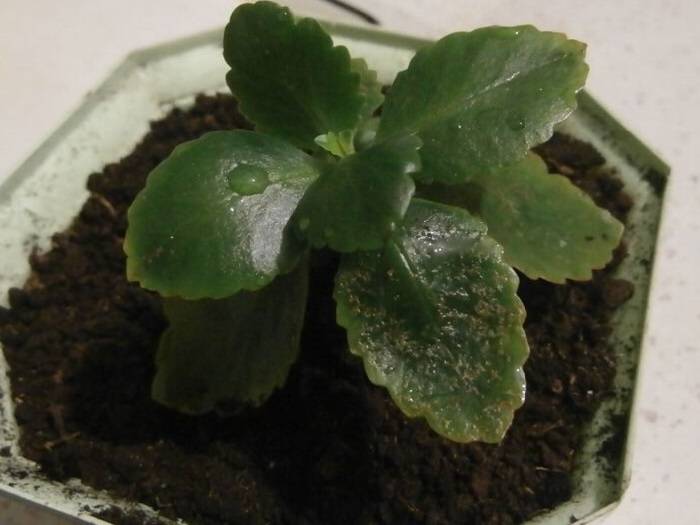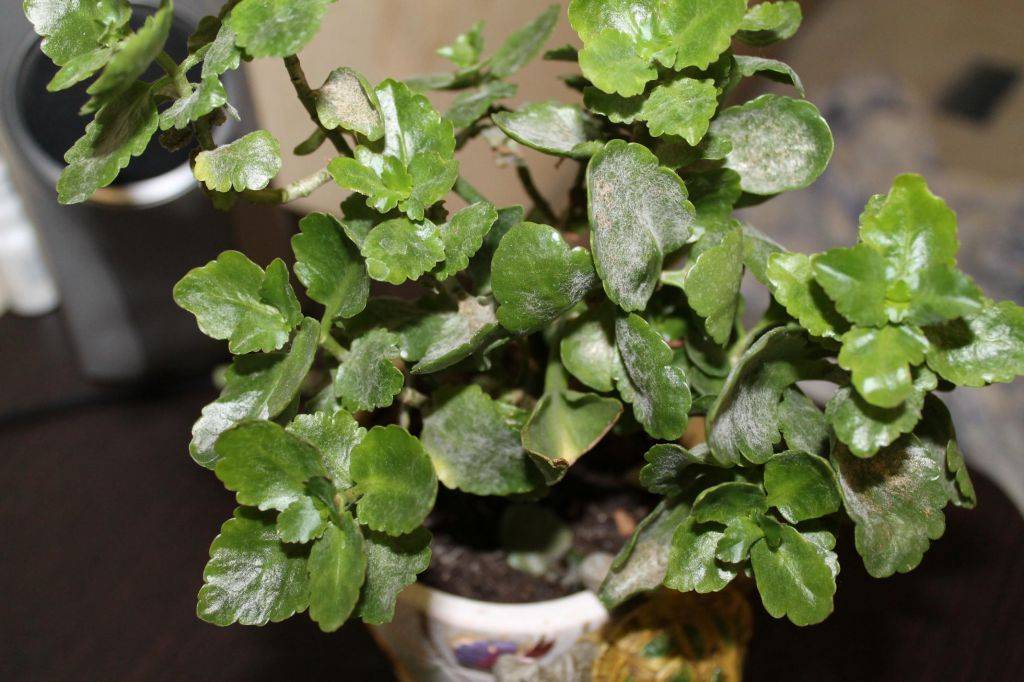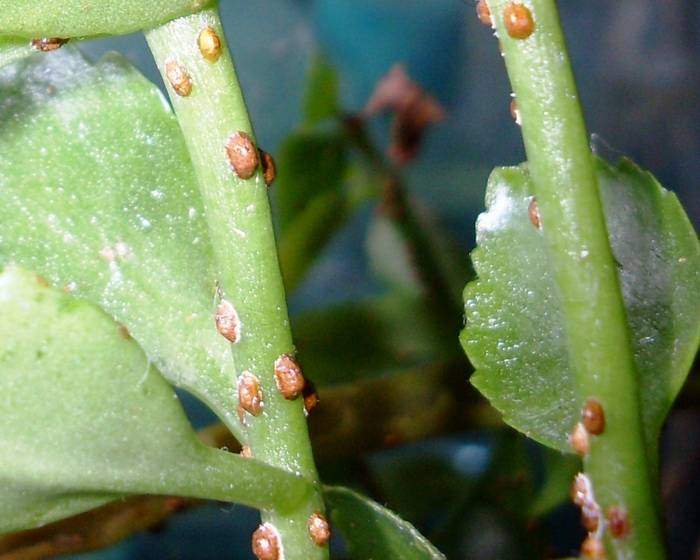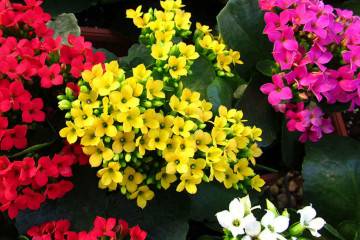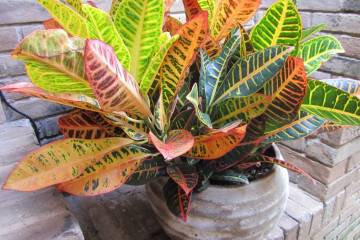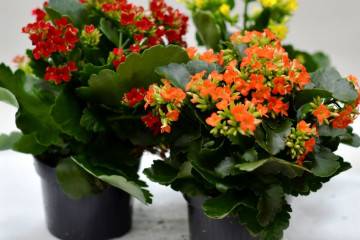Kalanchoe diseases - causes and treatment
Content:
Kalanchoe is not only a beautiful houseplant. Parts of it can be used to treat certain diseases, such as the Kalanchoe Deer Horn. However, the flower itself can get sick if you do not follow the rules of caring for it.
Why Kalanchoe leaves turn yellow, dry and wither
All succulent diseases are easily noticed by its appearance. If the leaves of the Kalanchoe turn yellow, begin to dry out, curl and fall off, it means that the plant is missing something.
Violation of the conditions of maintenance and care of the plant
The main reasons for problems with the foliage of a plant are violations of the rules for caring for it. It is worth paying attention to the following points:
- yellowing of the leaves, drying of the tips and strong upward growth indicate a lack of light. It is recommended to move the pot to a brighter place, but not in the sun;
- the constant falling of leaves is due to musty air. It is better to ventilate the room more often;
- dark spots on the leaves are often caused by sunburn. When a similar sign appears, you need to remove the pot to another place;
- lack of nutrients, especially after flowering, can also cause yellow foliage to fall off the plant;
- twisting of leaf plates occurs when there is an excess amount of nitrogen or peat in the soil. A culture transplant will be required in a more suitable soil;
- soft leaves and their falling off occurs with excessive watering or rotting of the root system. You can cope by reducing watering or curing the root system;
- lack of irrigation can also provoke shoots to fall off, the succulent can dry out, so you should regularly take care of the plant;
- too much sun exposure can also cause the entire flower to turn yellow.
These are the main reasons that are associated with a violation of the rules of care and causing diseases of the Kalanchoe leaves. However, various pests and diseases can affect the plant. To get rid of them, you need to take more serious measures.
Major succulent diseases and home therapy
Kalanchoe, like any plant, is susceptible to various diseases. It is important to determine the disease in time and start treatment so that the flower does not die.
Late blight
The disease actively affects garden and garden plants, but indoor flowers are also not immune from a similar problem. It is characterized by the appearance of brown spots on the leaves, which gradually turn black. After some time, the disease spreads to all branches and stems, they become soft and rot.
Incorrect and irregular watering, stagnation of moisture in the pot, unsuitable and too dense soil provoke the appearance of late blight. Often a similar disease is caused by irrigation with rainwater.
You can cope with the disease. To do this, remove all the affected leaves, the sections are treated with activated carbon.It is best to transplant the plant into a new pot, after irrigating it with a solution of potassium permanganate (1.5 g per 5 liters of water). Specific antifungal agents will help well.
Powdery mildew on Kalanchoe
Powdery mildew often appears on flowers next to each other in a warm, humid environment. Plaque on the leaves is noticeable on the Kalanchoe. When the temperature drops, the fungus will die, but the plant will not heal. The leaves will gradually curl and fall off, and the succulent will bloom poorly and little.
Many are interested in what to do if there is a white bloom on the leaves on the Kalanchoe. Treatment consists in complete control of watering, irrigation is carried out only at the root, moisture should not get on the leaf plates and stem. The pot is rearranged to another place, providing the Kalanchoe with more air and space. Be sure to carry out treatment with specific fungicides to kill the fungus.
Stem rot
The reason for this disease is a sharp drop in air temperature. When the plant is damaged, blackening of the stem and leaves, softness and rotting of all parts are noted.
The main treatment is to create optimal conditions for growth and development for the Kalanchoe. The normal temperature for a flower is 15-20 ° C in winter.
It is worth remembering that at low temperatures there should not be frequent watering in order to avoid rotting of the root system.
Gray rot
A similar disease affects indoor flowers quite often. The fungus quickly spreads to all parts of the plant. On the leaves, the presence of white dust is noticeable, located in small piles. Brown water spots are present on the stem. All parts of the plant located above the site of damage die off.
Gray mold often appears with irregular and improper watering. Constant stagnation of moisture provokes the development of the disease. It is imperative to remove fallen leaves from the pot in order to prevent fungal diseases.
Treatment is carried out with special fungicidal preparations, treating the plant twice with a break of 2 weeks. Solutions are prepared according to the instructions.
Ring spot
The disease is manifested by the formation of small spots on the leaf blades. At the first stage, they turn yellow, gradually turn brown. The disease develops for a very long time. At first, the specks are small in size, but gradually they merge into one large one. Leaves may turn yellow, dry out and fall off.
It is recommended to treat with special preparations, the pot is rearranged to a more spacious place.
In most cases, Kalanchoe diseases are provoked by fungi, which are very fond of high humidity. Therefore, it is important to irrigate the flower regularly, but make sure that there is no excess moisture.
Kalanchoe pests
In addition to improper care and disease, the Kalanchoe can be infested by harmful insects. They are also often carriers of fungi, viruses and bacteria. It is imperative to fight them. In most cases, special insecticides help.
Mealybug
Refers to dangerous pests. It is rather difficult to see on the plant due to its too small size. Mealybug damage is manifested as follows:
- the presence of small insects in the buds;
- falling leaves;
- the presence on the stem, branches, leaves of a sticky plaque - a waste product of the pest;
- with a serious lesion, a black bloom is noticeable on parts of the flower.
To get rid of the pest, use solutions of spark or actar preparations. However, if the plant is severely damaged, the remedies will not help; it is recommended to destroy the flower.
Shield
Damage to the scabbard can be seen visually if you carefully examine the flower. The signs are:
- the presence of brown blisters on the leaves and stem;
- leaf blades begin to dry out and fall off.
If signs are found, actar and spark are treated with chemical preparations. Before the procedure, insects are carefully removed from the plant. A cotton pad is moistened with alcohol or soapy water and the brown growths are carefully removed from parts of the Kalanchoe.
Aphid
Aphids are considered the most dangerous pest for indoor flowers. It quickly spreads and multiplies, after a short time it affects the entire plant and can pass on to others. For the defeat of aphids, the following signs are characteristic:
- on parts of the Kalanchoe, the presence of many microscopic insects is noticeable. They can be transparent or green;
- on the surface of the culture, the presence of a sticky coating with a yellowish tinge is felt;
- small dots appear on the plant, and then holes that aphids gnaw out.
Getting rid of insects is required very quickly. Otherwise, it will not be possible to save the Kalanchoe. For starters, you can try soaping the plant. It's easy to make: 100 g of laundry soap shavings are stirred in 1 liter of water. The agent is sprayed on the affected culture.
With a serious degree of the disease, only chemicals such as sparks, tanreca will help. It is permissible to carry out processing with boric acid.
Mites
Ticks on the Kalanchoe can be recognized by the presence of cobwebs on the back of the leaf plate. Insects are very fond of warm and dry air. It is rather difficult to consider them.
Kalanchoe leaves begin to curl, then turn yellow and fall off.
You can cope with harmful insects in similar ways using chemical insecticides. Prepare solutions following the instructions.
How to reanimate Kalanchoe after illness
After eliminating the cause of the disease, it is required to follow some rules in order for the plant to recover and begin to develop again. To do this, perform the following actions:
- watering is carried out no more than 1 time in 3 days, make sure that moisture does not stagnate;
- during the recovery period, it is better to do without spraying;
- provide a suitable temperature so that the Kalanchoe does not overheat and freeze.
It is recommended to keep a close eye on the flower. If necessary, you can remove some branches and leaves to update the bush.
Prevention of diseases and pests
Preventive actions consist in observing the correct care for the Kalanchoe.
Proper plant care
Kalanchoe is an unpretentious flower. Therefore, its content will not cause difficulties even for beginners, it requires:
- regular watering;
- lack of stagnant moisture;
- periodic pruning of shoots and lower leaves;
- compliance with the temperature regime;
- correct lighting;
- transplant every couple of years;
- airing the room;
- selection of a suitable soil;
- periodic feeding with mineral fertilizers.
Compliance with simple rules will help to avoid various diseases and pests.
Kalanchoe is a beautiful and useful plant. It is unpretentious, but if the rules of care are not followed, the development of serious diseases or damage by harmful insects is not excluded. When signs of disease appear, it is recommended to treat the flower with specific means and provide it with suitable conditions for growth and development.

